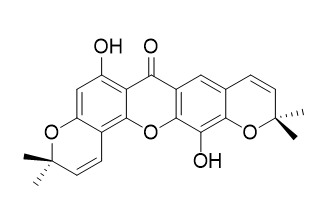Rheediaxanthone A
Rheediaxanthone A is a natural product from Calophyllum inophyllum.
Inquire / Order:
manager@chemfaces.com
Technical Inquiries:
service@chemfaces.com
Tel:
+86-27-84237783
Fax:
+86-27-84254680
Address:
1 Building, No. 83, CheCheng Rd., Wuhan Economic and Technological Development Zone, Wuhan, Hubei 430056, PRC
Providing storage is as stated on the product vial and the vial is kept tightly sealed, the product can be stored for up to
24 months(2-8C).
Wherever possible, you should prepare and use solutions on the same day. However, if you need to make up stock solutions in advance, we recommend that you store the solution as aliquots in tightly sealed vials at -20C. Generally, these will be useable for up to two weeks. Before use, and prior to opening the vial we recommend that you allow your product to equilibrate to room temperature for at least 1 hour.
Need more advice on solubility, usage and handling? Please email to: service@chemfaces.com
The packaging of the product may have turned upside down during transportation, resulting in the natural compounds adhering to the neck or cap of the vial. take the vial out of its packaging and gently shake to let the compounds fall to the bottom of the vial. for liquid products, centrifuge at 200-500 RPM to gather the liquid at the bottom of the vial. try to avoid loss or contamination during handling.
Nat Prod Sci.2018, 24(3):206
Biomed Pharmacother.2019, 111:262-269
J Agric Food Chem.2023, 71(47):18510-18523.
Pharmacogn Mag.2015, 11:S585-91
Planta Med.2024, 2328-2750
Molecules.2021, 26(2):E255.
Huazhong Agricultural University2022, pp34.
The Japan Society for Analy. Chem.2017, 66(8):613-617
Industrial Crops and Products2022, 188:115638
Tropical Journal of Pharmaceutical Research 2021, 20(6):1165-1170.
Related and Featured Products
Pak J Pharm Sci. 2015 Mar;28(2):425-9.
Antiproliferative xanthone derivatives from Calophyllum inophyllum and Calophyllum soulattri.[Pubmed:
25730799]
METHODS AND RESULTS:
Structure-activity relationships of eleven xanthones were comparatively predicted for four cancer cell lines after the compounds were subjected to antiproliferative assay against B-lymphocyte cells (Raji), colon carcinoma cells (LS174T), human neuroblastoma cells (IMR-32) and skin carcinoma cells (SK-MEL-28). The eleven chemical constituents were obtained naturally from the stem bark of Calophyllum inophyllum and Calophyllum soulattri. Inophinnin (1) and inophinone (2) were isolated from Calophyllum inophyllum while soulattrin (3) and phylattrin (4) were found from Calophyllum soulattri. The other xanthones were from both Calophyllum sp. and they are pyranojacareubin (5), Rheediaxanthone A (6), macluraxanthone (7), 4-hydroxyxanthone (8), caloxanthone C (9), brasixanthone B (10) and trapezifolixanthone (11).
CONCLUSIONS:
Compound 3 was found to be the most cytotoxic towards all the cancer cell lines with an IC50 value of 1.25μg/mL while the simplest xanthone, compound 8 was inactive.



